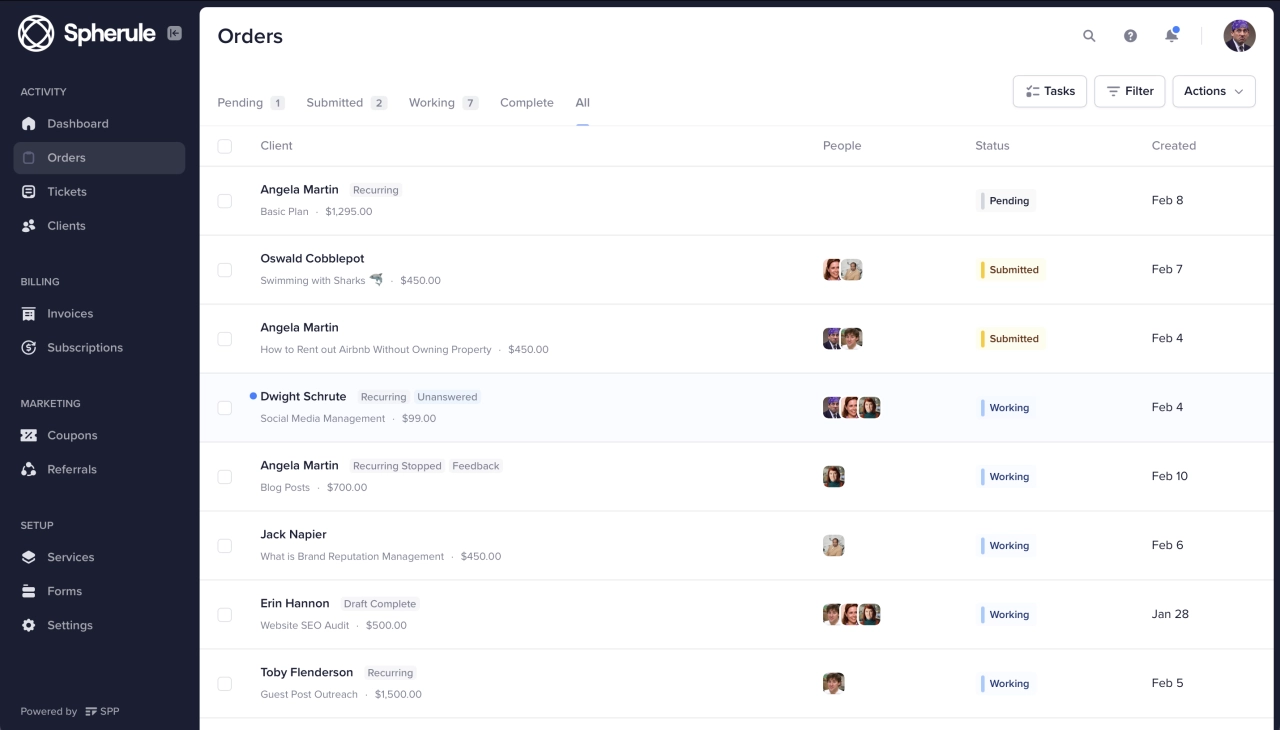Capacity Calculator for productized Agencies
Understand how many packages you can deliver with your current team resources
Team Resources
Capacity Analysis
Team Capacity
600 hours/month
Current Utilization
510 hours (85%)
Available Capacity
90 hours
Maximum Delivery Capacity
Additional Capacity
Frequently Asked Questions
- What does this calculator help me understand?
-
This calculator helps productized agencies understand exactly how many client packages they can deliver with their current team resources. It answers critical operational questions such as:
- How many total clients can we handle across different package types?
- How much of our capacity are we currently using?
- How many more clients can we take on?
- When should we consider hiring more team members?
By providing clear visibility into your team's capacity, this calculator helps prevent overselling and identifies hiring trigger points before you reach a capacity crisis.
- What are the best practices for capacity management?
-
Based on industry experience, here are some best practices for capacity management:
- Target 80-85% utilization : This allows buffer for unexpected work, client emergencies, and team absences
- Update regularly : Recalculate capacity at least monthly as team size and client mix changes
- Start hiring at 90% utilization : Given that hiring and onboarding take time, begin the process before reaching capacity
- Track actual hours : Compare estimated package hours with actual delivery time to refine your inputs
- Consider skill sets : This calculator assumes all specialists can work on all packages; adjust if you have specialists with different skills
- Plan for vacations : Reduce available capacity during heavy vacation periods
Remember that sustainable growth requires maintaining some flexibility in your capacity rather than operating at 100% utilization.
- How accurate is the "Productive Hours" estimation?
-
The "Productive Hours per Month" is often the most misunderstood and incorrectly estimated input. Here's how to think about it:
For a full-time employee working ~160 hours per month (40 hours × 4 weeks):
- NOT 160 hours : A specialist isn't productively working on billable client work for every minute of their workday
- Typically 120-140 hours : Most agencies find their team members can dedicate 75-85% of their time to direct client work
Common non-productive time includes:
- Internal meetings (10-15 hours/month)
- Administrative tasks (5-10 hours/month)
- Learning and skill development (5-10 hours/month)
- Breaks and unavoidable downtime (10-15 hours/month)
Be cautious about overestimating productive hours, as this is a common cause of capacity issues and team burnout.
- How do I account for different skill sets on my team?
-
This calculator assumes all specialists can work on all package types, which may not be the case if you have team members with specialized skills. Here are some approaches to account for this:
- Separate calculations : Run the calculator multiple times, once for each specialized team (e.g., design team, development team)
- Weighted specialization : Adjust the "Number of Specialists" to reflect the equivalent full-time specialists who can work on a particular package
- Focus on bottlenecks : Base your calculations on the most constrained resource or specialized role
For example, if you have 10 specialists but only 3 can work on Package A, you might set "Number of Specialists" to 3 when calculating capacity for Package A.
For complex team structures with multiple specializations, you might need a more sophisticated capacity planning tool that can account for specific skill allocations.
- Can I use this calculator for mixed service models?
-
Yes, you can adapt this calculator for agencies with both productized services and custom services:
- For productized services : Use the calculator as designed, with each package representing a defined service offering
- For custom work : Create a "Custom Projects" package where the hours represent your average monthly custom project commitment
For example:
- Package A: Social Media Management (25 hours/month/client)
- Package B: SEO Service (15 hours/month/client)
- Package C: Custom Projects (50 hours/month allocated to custom work)
In this approach:
- Set your "Current Utilization" to include all currently committed work (both productized and custom)
- For custom work capacity, the result will show "clients" which actually represents how many average custom projects you can handle
- How can I use this calculator for sales forecasting?
-
This calculator can be a powerful tool for aligning sales targets with production capacity:
Setting realistic sales targets:
- Calculate your additional capacity for each package type
- Use these figures to set maximum new client goals for your sales team
- Create a sales timeline that matches your team's ability to onboard new clients
- If sales projections exceed capacity, calculate how many new specialists you'll need
- Plan hiring timelines based on sales forecasts and onboarding periods
- Create triggers for initiating the hiring process (e.g., when utilization reaches 90%)
Regularly updating your capacity calculations ensures sales and operations stay aligned as your agency grows.
- How do I handle variable package scopes?
-
If your package scopes vary from client to client, try these approaches:
Approach 1: Use average hours
- Calculate the average hours spent across all clients for each package type
- Use this average in the calculator
- Update regularly as you gather more data
Approach 2: Create sub-packages
- Split variable packages into distinct sub-packages (e.g., Small, Medium, Large)
- Enter each as a separate package type
- Track how many of each size you currently have and plan to sell
Approach 3: Use conservative estimates
- Use the higher end of your hour range for calculations
- This builds in a safety buffer for variable scopes
- If consistently under this estimate, gradually adjust downward
For each package, create clear scope boundaries to help manage client expectations and maintain profitability.
- What are common capacity management mistakes to avoid?
-
Based on agency experience, here are common pitfalls to avoid:
- Overestimating productive hours : Assuming specialists can work 40 hours/week on client work
- Ignoring skill specialization : Not accounting for the fact that not all team members can work on all package types
- Running too lean : Operating consistently above 90% utilization, leaving no buffer for emergencies
- Reacting too late : Waiting until you're at 100% capacity before starting the hiring process
- Neglecting scope creep : Not adjusting capacity calculations when packages consistently take longer than estimated
- Forgetting non-package work : Not accounting for one-off client requests, maintenance, or internal projects
- Static planning : Calculating capacity once and not updating as conditions change
Best practices to counter these mistakes:
- Track actual time spent on packages to refine your estimates
- Update your calculations monthly
- Start hiring when reaching 85-90% utilization
- Include buffer time in your package hour estimates
- Create clear scope boundaries for each package
- How does this calculator help with pricing decisions?
-
While primarily a capacity tool, this calculator provides valuable insights for pricing :
Understanding time costs:
- Clearly shows how many hours different packages require
- Helps identify if certain packages are underpriced relative to their time requirements
- Reveals if packaging structure is efficient for your team's capacity
Package efficiency analysis:
- Compare hours-per-package against revenue-per-package
- Calculate effective hourly rates for each package (package price ÷ package hours)
- Identify which packages provide the best revenue-to-effort ratio
Margin protection:
- If time tracking shows package hours creeping up, you can proactively adjust pricing
- When at high utilization, you might increase prices to slow sales while maintaining revenue growth
- If at low utilization, you might offer limited-time promotions to fill capacity

You're in good company. We've helped agencies like yours sell $500M+ in services.


